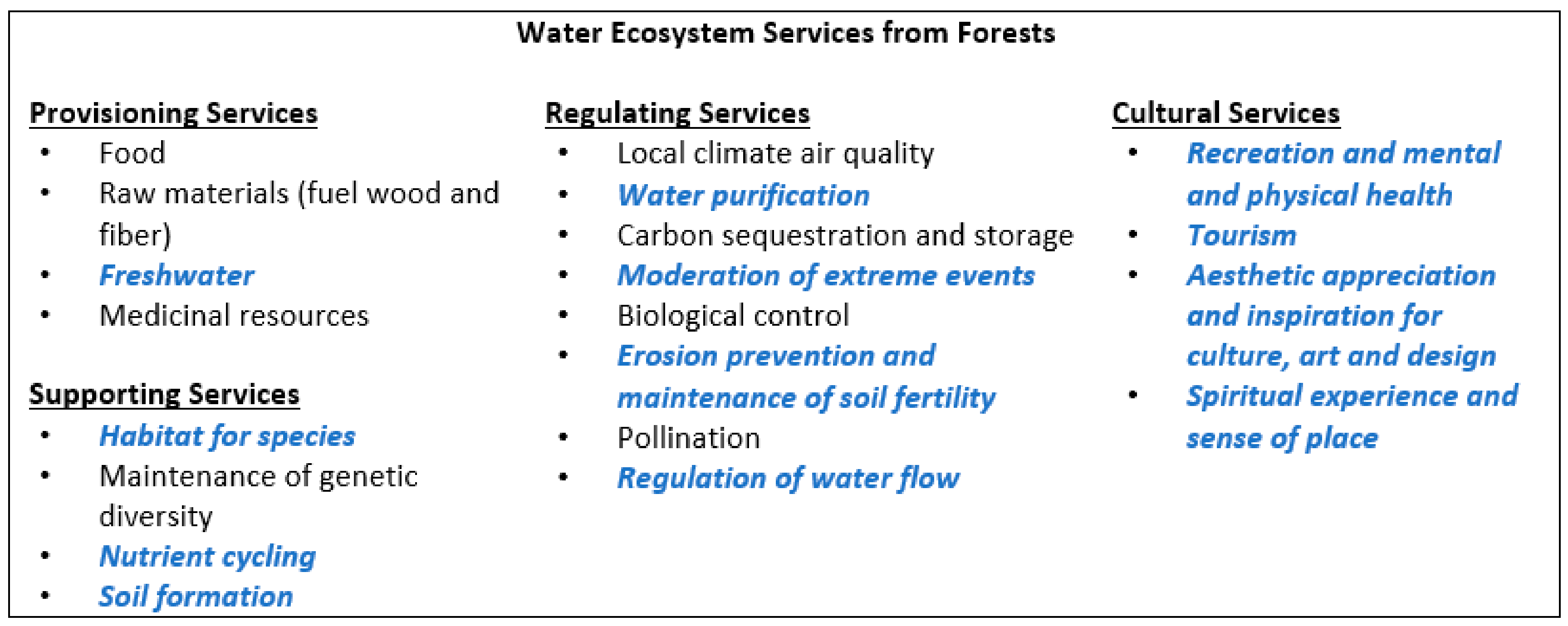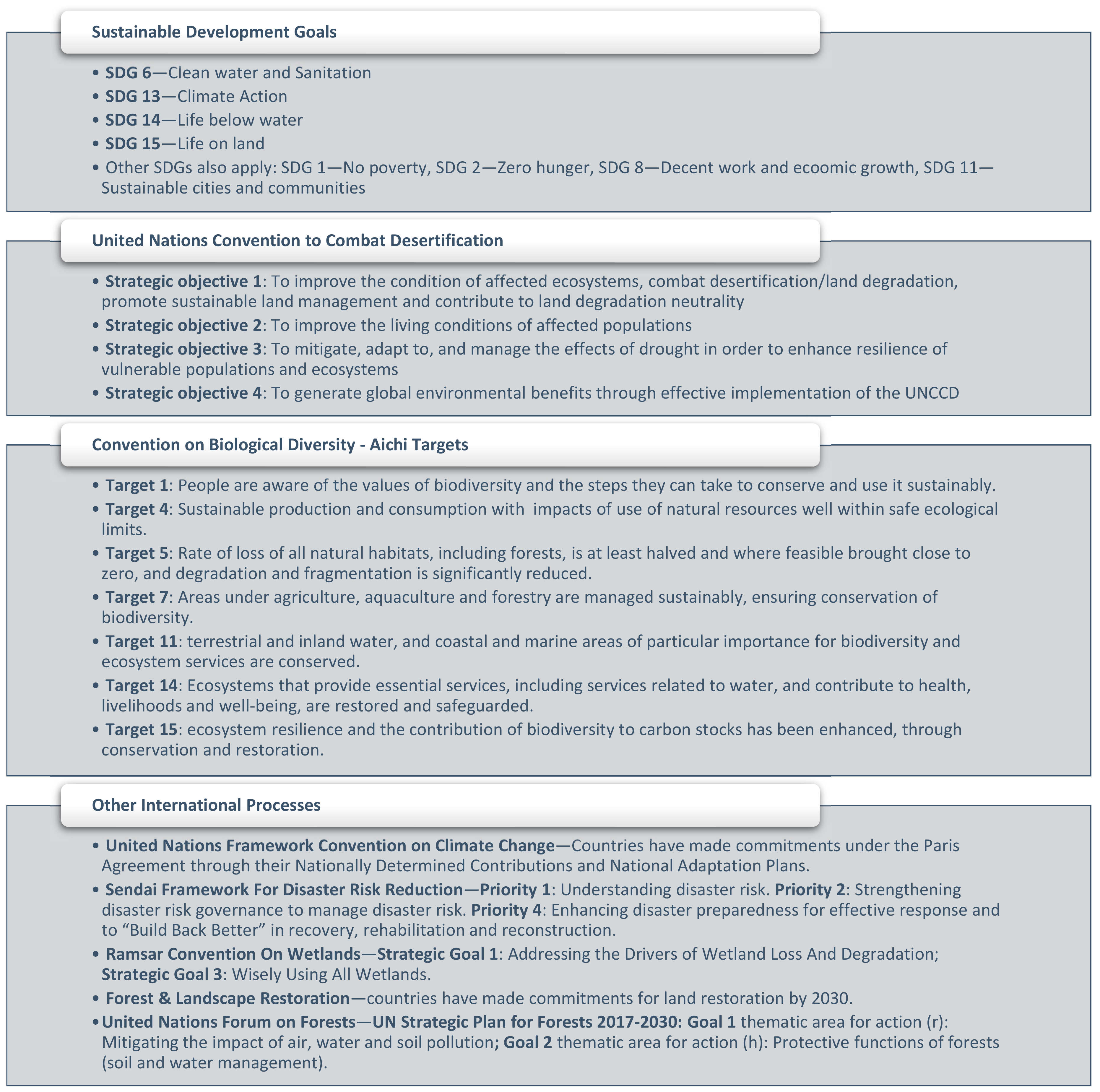The Forest–Water Nexus: An International Perspective
Abstract
:1. Introduction
2. Methodology
2.1. Forests and Water Within the International Political Agenda
2.1.1. Forests and Water within the 2030 Agenda for Sustainable Development
2.1.2. Forests and Water in Climate Change
2.2. Analysis of Global Forest–Water Datasets
2.2.1. Tree Cover and Water Risk
2.2.2. Forests Managed for Soil and/or Water Protection
3. Results
3.1. Forests and Water Within the International Policy Agenda
3.1.1. Sustainable Development Goals
3.1.2. Forests and Water in Climate Change
3.2. Analysis of Global Forest–Water Datasets
3.2.1. Tree Cover and Water Risk
3.2.2. Forests Managed for Soil and/or Water Conservation
4. Discussion
4.1. The Forest–Water Nexus Is a Human Well-Being Issue
4.2. International Momentum
4.2.1. Sustainable Development Goals
4.2.2. Forests and Water in Climate Change
4.2.3. Further International Momentum Required
4.3. Big Picture (Global) Data Is Needed
5. Conclusions
Author Contributions
Funding
Acknowledgments
Conflicts of Interest
Appendix A
References
- Ellison, D.; Morris, C.E.; Locatelli, B.; Sheil, D.; Cohen, J.; Murdiyarso, D.; Gutierrez, V.; van Noordwijk, M.; Creed, I.; Pokorny, J.; et al. Trees, forests and water: Cool insights for a hot world. Glob. Environ. Chang. 2017, 43, 51–61. [Google Scholar] [CrossRef]
- Creed, I.F.; van Noordwijk, M. Forest and Water on a Changing Planet: Vulnerability, Adaptation and Governance Opportunities: A Global Assessment Report; International Union of Forest Research Organizations: Austria, Vienna, 2018. [Google Scholar]
- MEA (Millenium Ecosystem Assessment). Global Assessment Report; Island Press: Washington, DC, USA, 2005. [Google Scholar]
- Springgay, E.; Dalton, J.; Samuelson, L.; Bernard, A.; Buck, A.; Cassin, J.; Matthews, N.; Matthews, J.; Tengberg, A.; Bourgeois, J.; et al. Championing the Forest–Water Nexus. Report on the Meeting of Key Forest and Water Stakeholders; SIWI: Stockholm, Sweden, 2018. [Google Scholar]
- WRI (World Resource Institute). Global forest water watch. Available online: https://www.globalforestwatch.org/ (accessed on 27 May 2019).
- FAO (Food and Agricultural Organization). Global Forest Resources Assessment 2015: How Are the World’s Forests Changing, 2nd ed.; Food and Agricultural Organization: Rome, Italy, 2015. [Google Scholar]
- UNFCCC NDC Registry. Available online: https://www4.unfccc.int/sites/NDCStaging/Pages/All.aspx (accessed on 31 May 2019).
- (I)NDC Submission Portal. Available online: https://www4.unfccc.int/sites/submissions/indc/ Submission%20Pages/submissions.aspx (accessed on 31 May 2019).
- Hansen, M.C.; Potapov, P.V.; Moore, R.; Hancher, M.; Turubanova, S.A.; Tyukavina, A.; Thau, D.; Stehman, S.V.; Goetz, S.J.; Loveland, T.R.; et al. High-resolution global maps of 21st-century forest cover change. Science 2013, 342, 850–853. [Google Scholar] [CrossRef] [PubMed]
- FAO (Food and Agriculture Organization). World Map of the Major Hydrological Basins (Derived From HydroSHEDS); Food and Agriculture Organization: Rome, Italy, 2011. [Google Scholar]
- Qin, Y.; Gartner, T.; Minnemeyer, S.; Reig, P.; Sargent, S. Global Forest Watch Water Metadata Document. Technical Note; World Resources Institute: Washington, DC, USA, 2016. [Google Scholar]
- Renard, K.G.; Foster, G.R.; Weesies, G.A.; McCool, D.K.; Yoder, D.C. Predicting soil erosion by water: A guide to conservation planning with the Revised Universal Soil Loss Equation (RUSLE). In Agriculture Handbook; U.S. Department of Agriculture: Washington, DC, USA, 1997. [Google Scholar]
- Hofste, R.W.; Kuzma, S.; Walker, S.; Sutanudjaja, E.H.; Bierkens, M.F.P.; Kujiper, M.J.M.; Sanchez, M.F.; van Beek, R.; Wada, Y.; Rodríguez, S.G.; et al. Aqueduct 3.0: Updated Decision-Relevant Global Water Risk Indicators; World Resources Institute: Washington, DC, USA, 2019; Technical Note. [Google Scholar]
- FAO (Food and Agricultural Organization). The State of the World’s Forests 2018—Forest Pathways to Sustainable Development; Food and Agricultural Organization: Rome, Italy, 2018. [Google Scholar]
- UNSTATS (United Nations Statistics Division). Tier Classification for Global SDG Indicators; United Nations Statistics Division: New York, NY, USA, 2019. Available online: https://unstats.un.org/sdgs/files/ Tier_Classification_of_SDG_Indicators_22_May_2019_web.pdf (accessed on 1 July 2019).
- UNECE/FAO (United Nations Economic Commission for Europe/Food and Agriculture Organization). Forests and Water: Valuation and Payments for Forest Ecosystem Services; United Nations Economic Commission for Europe/Food and Agriculture Organization: Geneva, Switzerland, 2018. [Google Scholar]
- Bruijnzeel, L.A. Hydrological functions of tropical forests: Not seeing the soil for the trees? Agric. Ecosyst. Environ. 2014, 104, 185–228. [Google Scholar] [CrossRef]
- United States Forestry Service. Water, Air, and Soil. Available online: https://www.fs.fed.us/science-technology/water-air-soil (accessed on 27 May 2019).
- UNU (United Nations University Institute for Water, Environment & Health). Water Security & the Global Water Agenda. A UN-Water Analytical Brief; United Nations University Institute for Water, Environment & Health: Hamilton, ON, Canada, 2013. [Google Scholar]
- 2030 Water Resources Group. Charting Our Water Future: Economic Frameworks to Inform Decision-Making; 2030 WRG: Washington, DC, USA, 2009. [Google Scholar]
- WWAP (United Nations World Water Assessment Programme). The United Nations World Water Development Report 2015: Water for a Sustainable World; UNESCO: Paris, France, 2015. [Google Scholar]
- Mekonnen, M.M.; Hoekstra, A. Four billion people facing severe water scarcity. Sci. Adv. 2016, 2, 1–6. [Google Scholar] [CrossRef] [PubMed]
- Bastin, J.F.; Finegold, Y.; Garcia, C.; Mollicone, D.; Rezende, M.; Routh, D.; Zohner, CM.; Crowther, T.W. The extent of forest in dryland biomes. Science 2017, 356, 635–638. [Google Scholar] [CrossRef] [PubMed] [Green Version]
- FAO (Food and Agricultural Organization). Forests and Water: International Momentum and Action; Food and Agricultural Organization: Rome, Italy, 2013. [Google Scholar]
- SIWI (Stockholm International Water Institute). Water: The Path to Agenda 2030 Implementation; Stockholm International Water Institute: Stockholm, Sweden, 2018; Available online: https://www.siwi.org/wp-content/uploads/2018/06/Water-the-path-to-Agenda-2030-implementation_WEB.pdf (accessed on 28 May 2019).
- ECOSOC (United Nations Economic and Social Council). Special Edition: Progress towards the Sustainable Development Goals. Report of the Secretary-General; United Nations Economic and Social Council: New York, NY, USA, 2019; Available online: https://unstats.un.org/sdgs/files/report/2019/secretary-general-sdg-report-2019--EN.pdf (accessed on 13 September 2019).
- UN Environment. Progress on Water-related Ecosystems—Piloting the Monitoring Methodology and Initial Findings for SDG Indicator 6.6.1; UN Environment: Geneva, Switzerland, 2018; Available online: http://www.unwater.org/app/uploads/2018/08/661-progress-on-water-related-ecosystems-2018.pdf (accessed on 11 September 2019).
- UN-Water. Integrated Monitoring Guide for Sustainable Development Goal 6 on Water and Sanitation: Targets and Global Indicators; UN Environment: Geneva, Switzerland, 2017; Available online: https://www.unwater.org/app/uploads/2017/10/G2_Targets-and-global-indicators_Version-2017-07-14.pdf (accessed on 11 September 2019).
- Gustafsson, M. The Forest–Water Nexus in (I)NDC Reviews—identifying Good Examples and Gaps to Address; Stockholm International Water Institute: Stockholm, Sweden, 2019; Unpublished work. [Google Scholar]
- FAO (Food and Agricultural Organization). The Agriculture Sectors in the Intended Nationally Determined Contributions: Analysis. Environment and Natural Resources Management Working Paper No. 62; Food and Agricultural Organization: Rome, Italy, 2016. [Google Scholar]
- French Water Partnership and Coalition Eau. Review of the Integration of Water within the Intended Nationally Determined Contributions (INDCs) for COP21. 2016. Available online: http://www.coalition-eau.org/wpcontent/uploads/2016-03-review-of-water-integration-in-indc-vf.pdf (accessed on 30 May 2019).
- WWF (World Wildlife Fund). INDC Analysis: An Overview of the Forest Sector. 2015. Available online: http://wwf.panda.org/wwf_news/?257883/INDC-Analysis-An-Overview-of-the-Forest-Sector (accessed on 30 May 2019).
- GIZ (Deutsche Gesellschaft für Internationale Zusammenarbeit). Sectoral Implementation of Nationally Determined Contributions (NDCs). 2017. Available online: https://www.transparency-partnership.net/sites/default/files/u2618/giz2017-en-ndcs-sectoralimplementation-forestry.pdf (accessed on 30 May 2019).
- IUCN (International Union for Conservation of Nature). Forest Landscape Restoration: Unlocking the Mitigation and Adaptation Potential of the Forest and Land Sector, IUCN Brief. No. 21; IUCN: Gland, Switzerland, 2017; Available online: https://www.iucn.org/sites/dev/files/content/documents/ 20171107_iucn_forest_brief_21.pdf (accessed on 30 May 2019).
- IPBES (Intergovernmental Science-Policy Platform on Biodiversity and Ecosystem Services). Report of the Plenary of the Intergovernmental Science-Policy Platform on Biodiversity and Ecosystem Services on the Work of Its Seventh Session; Intergovernmental Science-Policy Platform on Biodiversity and Ecosystem Services: Bonn, Germany, 2019; Available online: www.ipbes.net/system/tdf/ipbes_7_10_add-1-_advance_0.pdf?file=1&type=node&id=35245 (accessed on 31 May 2019).
- General Assembly of the United Nations. Resolution Adopted by the General Assembly on 6 July 2017 (Res/71/313). 2017. Available online: https://undocs.org/A/RES/71/313 (accessed on 1 July 2019).








| Forest–Water Keywords | Contextual Keywords | |
|---|---|---|
|
|
|
| Risk/% Tree Loss | 1 | 2 | 3 | 4 | 5 | Total |
|---|---|---|---|---|---|---|
| <10% | 10 | 18 | 12 | 3 | 7 | 50 |
| 10%–20% | 6 | 6 | 3 | 2 | 1 | 18 |
| 20%–30% | 15 | 7 | 3 | 4 | 3 | 32 |
| 30%–40% | 7 | 5 | 4 | 6 | 5 | 27 |
| 40%–40% | 4 | 3 | 2 | 3 | 5 | 17 |
| 50%–60% | 0 | 1 | 9 | 8 | 8 | 26 |
| 60%–70% | 1 | 4 | 6 | 5 | 4 | 20 |
| 70%–80% | 1 | 1 | 2 | 9 | 2 | 15 |
| 80%–90% | 0 | 1 | 4 | 3 | 6 | 14 |
| >90% | 0 | 1 | 2 | 1 | 7 | 11 |
| Total Watersheds | 44 | 47 | 47 | 44 | 48 | 230 |
| FAO Region/ Keyword | Africa | Asia | Europe | North and Central America | Oceania | South America | GLOBAL |
|---|---|---|---|---|---|---|---|
| Mangrove | 17% | 19% | - | 43% | 19% | 17% | 20% |
| Swamp Forest | - | 4% | - | - | - | - | 1% |
| Rainforest | 2% | 2% | - | - | - | 8% | 2% |
| Wetland | 11% | 6% | - | 17% | - | 17% | 9% |
| Riparian | 2% | 4% | - | 9% | - | - | 3% |
| IRM | 49% | 30% | - | 43% | 13% | 42% | 34% |
| FAO Region/Forest–Water Context | Africa | Asia | Europe | North and Central America | Oceania | South America | Global |
|---|---|---|---|---|---|---|---|
| Water ecosystem services provided by forests | 36% | 34% | 6% | 43% | 13% | 67% | 33% |
| Integrated forest and water management | 34% | 21% | 0% | 35% | 13% | 33% | 25% |
| Clean Water | Forest Area (%) | Erosion Control | Forest Area (%) | Desertification Control | Forest Area (%) | Coastal Stabilization | Forest Area (%) |
|---|---|---|---|---|---|---|---|
| Japan | 36.7% | Timor-Leste | 32.4% | Uzbekistan | 80.3% | Cuba | 18.3% |
| Guadeloupe | 25.1% | Austria | 29.8% | Iceland | 34.8% | Lithuania | 8.0% |
| Uruguay | 19.8% | Switzerland | 27.5% | Mauritania | 17.4% | Bangladesh | 4.3% |
| Mauritius | 14.8% | Ukraine | 25.2% | Mauritius | 17.4% | Ukraine | 3.5% |
| Bangladesh | 13.5% | Tajikistan | 25.0% | Oman | 15.0% | Belarus | 3.4% |
| Tonga | 11.1% | Romania | 20.4% | Sudan | 13.0% | Guadeloupe | 3.0% |
| Romania | 10.6% | Guadeloupe | 17.3% | Tajikistan | 12.1% | Russia | 3.0% |
| Slovenia | 10.5% | Serbia | 17.1% | Bangladesh | 2.4% | Jamaica | 2.8% |
| Sierra Leone | 9.4% | Slovakia | 16.9% | Serbia | 1.2% | Malaysia | 1.5% |
| Malaysia | 9.0% | Turkey | 13.9% | Chad | 0.4% | Portugal | 1.4% |
© Food and Agriculture Organization of the United Nations, 2019. Licensee MDPI, Basel, Switzerland. This article is an open access article distributed under the terms and conditions of the Creative Commons Attribution (CC BY) license (http://creativecommons.org/licenses/by/4.0/).
Share and Cite
Springgay, E.; Casallas Ramirez, S.; Janzen, S.; Vannozzi Brito, V. The Forest–Water Nexus: An International Perspective. Forests 2019, 10, 915. https://doi.org/10.3390/f10100915
Springgay E, Casallas Ramirez S, Janzen S, Vannozzi Brito V. The Forest–Water Nexus: An International Perspective. Forests. 2019; 10(10):915. https://doi.org/10.3390/f10100915
Chicago/Turabian StyleSpringgay, Elaine, Sara Casallas Ramirez, Sally Janzen, and Vitor Vannozzi Brito. 2019. "The Forest–Water Nexus: An International Perspective" Forests 10, no. 10: 915. https://doi.org/10.3390/f10100915
APA StyleSpringgay, E., Casallas Ramirez, S., Janzen, S., & Vannozzi Brito, V. (2019). The Forest–Water Nexus: An International Perspective. Forests, 10(10), 915. https://doi.org/10.3390/f10100915




